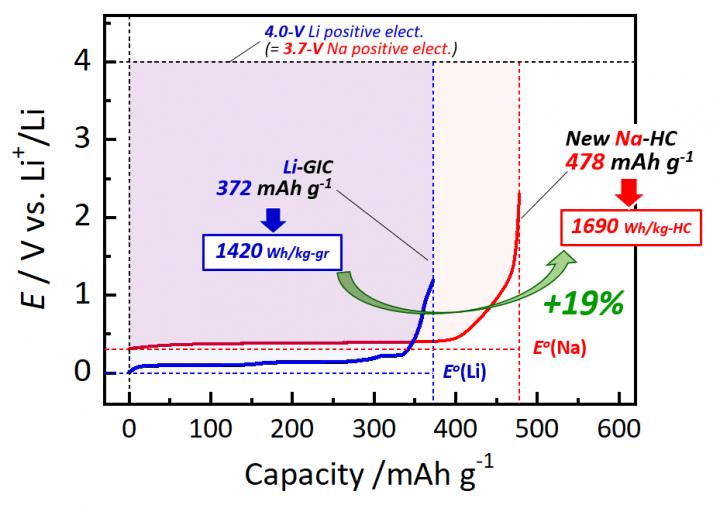New sodium-storing electrode material for rechargeable batteries with unprecedented energy density

Credit: Shinichi Komaba from Tokyo University of Science
Cost-effective rechargeable batteries are at the heart of virtually all portable electronic devices, which have become ubiquitous in modern daily life. Moreover, rechargeable batteries are essential components in many environment-friendly technologies, such as electric cars and systems that harvest renewable energy. They are also key enablers of various medical devices and facilitate research in various fields as the energy source of electronic sensors and cameras. So, it shouldn’t come as a surprise that there is a lot of effort spent in developing better and cheaper rechargeable batteries.
So far, rechargeable lithium-ion batteries hold the number-one spot thanks to their great performance across the board in terms of capacity, stability, price, and charging time. However, lithium, and other minor and costly metals like cobalt and copper, are not among the most abundant materials on the earth’s crust, and their ever-increasing demand will soon lead to supply problems around the world. At the Tokyo University of Science, Japan, Professor Shinichi Komaba and colleagues have been striving to find a solution to this worsening conundrum by developing rechargeable batteries using alternative, more abundant materials.
In a recent study published in Angewandte Chemie International Edition, the team found an energy efficient method to produce a novel carbon-based material for sodium-ion batteries. Apart from Prof. Komaba, the team also included Ms. Azusa Kamiyama and Associate Prof. Kei Kubota from Tokyo University of Science, Dr. Yong Youn and Dr. Yoshitaka Tateyama from National Institute for Materials Science, Japan, and Associate Prof. Kazuma Gotoh from Okayama University, Japan. The study focused on the synthesis of hard carbon, a highly porous material that serves as the negative electrode of rechargeable batteries, through the use of magnesium oxide (MgO) as an inorganic template of nano-sized pores inside hard carbon.
The researchers explored a different technique for mixing the ingredients of the MgO template so as to precisely tune the nanostructure of the resulting hard carbon electrode. After multiple experimental and theoretical analyses, they elucidated the optimal fabrication conditions and ingredients to produce hard carbon with a capacity of 478 mAh/g, the highest ever reported in this type of material. Prof. Komaba states, “Until now, the capacity of carbon-based negative electrode materials for sodium-ion batteries was mostly around 300 to 350 mAh/g. Though values near 438 mAh/g have been reported, those materials require heat treatment at extremely high temperatures above 1900°C. In contrast, we employed heat treatment at only 1500°C, a relatively low temperature.” Of course, with lower temperature comes lower energy expenditure, which also means lower cost and less environmental impact.
The capacity of this newly developed hard carbon electrode material is certainly remarkable, and greatly surpasses that of graphite (372 mAh/g), which is currently used as the negative electrode material in lithium-ion batteries. Moreover, even though a sodium-ion battery with this hard carbon negative electrode would in theory operate at a 0.3-volt lower voltage difference than a standard lithium-ion battery, the higher capacity of the former would lead to a much greater energy density by weight (1600 Wh/kg versus 1430 Wh/kg), resulting in +19% increase of energy density.
Excited about the results and with his eyes on the future, Prof. Komaba remarks, “Our study proves that it is possible to realize high-energy sodium-ion batteries, overturning the common belief that lithium-ion batteries have a higher energy density. The hard carbon with extremely high capacity that we developed has opened a door towards the design of new sodium-storing materials.”
Further studies will be required to verify that the proposed material actually offers superior lifetime, input-output characteristics, and low temperature operation in actual sodium-ion batteries. With any luck, we might be on the verge of witnessing the next generation of rechargeable batteries!
###
About The Tokyo University of Science
Tokyo University of Science (TUS) is a well-known and respected university, and the largest science-specialized private research university in Japan, with four campuses in central Tokyo and its suburbs and in Hokkaido. Established in 1881, the university has continually contributed to Japan’s development in science through inculcating the love for science in researchers, technicians, and educators.
Website: https:/
About Professor Shinichi Komaba from Tokyo University of Science
Prof. Shinichi Komaba obtained his Ph.D. from Waseda University, Japan, and then joined Iwate University as a research associate. After studying as a post-doctoral researcher at Bordeaux-CNRS, France, he joined Tokyo University of Science in 2005 to work on developing electrodes, electrolytes, and binding materials for various types of rechargeable batteries. His research group carries out cutting-edge research in the field of rechargeable batteries and their electrochemical applications. With more than 270 publications to his credit, Prof. Komaba has won numerous international awards, including the title of “Highly Cited Researcher” in 2019 and 2020.
Funding information
This work was partly supported by MEXT program “Elements Strategy Initiative to Form Core Research Center” (Grant No. JPMXP0112101003) and by JST through CONCERT-Japan program of SICORP (Grant No. JPMJSC17C1).
Media Contact
Tsutomu Shimizu
[email protected]
Original Source
https:/
Related Journal Article
http://dx.




